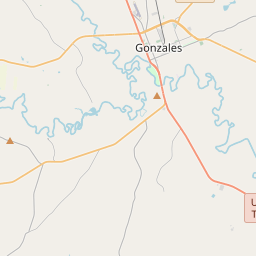Episcopal Church of the Messiah







Following early missionary efforts in the Gonzales area, the Episcopal Church of the Messiah was established in 1855. Land at this site was granted by city officials, and construction of the Gothic Revival sanctuary was completed in 1881. The original wooden belfry was replaced by the native stone bell tower in 1928. Interior furnishings include walnut woodwork produced from trees in the Guadalupe River area. Recorded Texas Historic Landmark - 1981
As one of the most visible programs of the Texas Historical Commission (THC), historical markers commemorate diverse topics in Texas history, including: the history and architecture of houses, commercial and public buildings, religious congregations, and military sites; events that changed the course of local and state history; and individuals who have made lasting contributions to the state, community organizations, and businesses.
The Battle of San Jacinto fought on April 21, 1836, was the decisive battle of the Texas Revolution, and led to the capture of Santa Anna and the end of the conflict.
Following the Texas Revolution and the establishment of the Republic of Texas, Gonzales County played a vital role in the formation of the new state. The town of Gonzales became the capital of DeWitt County and remained a prominent center for trade and agriculture. The 1850s brought an influx of German immigrants to the area, who brought with them their agricultural expertise and helped to further develop the county's economy.
During the Civil War, Gonzales County primarily sided with the Confederacy, and many residents served in the Confederate Army. After the war, the county faced a period of reconstruction and struggled with political and economic challenges. However, through the late 19th and early 20th centuries, the discovery of oil and the expansion of the cattle industry brought renewed growth and prosperity to Gonzales County.
Today, Gonzales County remains a vibrant community with a mix of agriculture, oil and gas production, and diverse industries. The county is also known for its rich cultural heritage, including historical sites and the annual reenactment of the Battle of Gonzales. The county's history is celebrated and preserved through museums, historical markers, and the pride of its residents in their shared past.
Gonzales County Timeline
This timeline provides a concise overview of the key events in the history of Gonzales County, Texas.
- 1834 - Gonzales County established as a municipality of Mexico
- 1835 - "Come and Take It" cannon skirmish occurs in Gonzales, marking the start of the Texas Revolution
- 1836 - Texas gains independence from Mexico; Gonzales County becomes part of the Republic of Texas
- 1846 - Texas becomes a state, and Gonzales County remains a political subdivision
- 1861-1865 - Gonzales County residents participate in the American Civil War
- 1878 - The Gonzales Inquirer, the oldest continuously published weekly newspaper in Texas, is established
- 1887 - Gonzales County Courthouse is built
- 1891 - The Harwood and Gonzales Railway connects Gonzales to the Texas railway network
- 1905 - Oil is discovered in Gonzales County, leading to an economic boom
- 1936 - The Gonzales Warm Springs Rehabilitation Center, now the J.B. Wells Park, opens as a medical facility for polio patients
- 1949 - The Gonzales Memorial Museum is established to preserve local history
- 1967 - The Gonzales State School opens to serve individuals with intellectual and developmental disabilities
- 1988 - The Confederate Soldiers Monument is erected in the Gonzales Memorial Museum